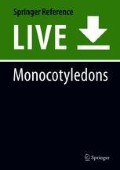Abstract
A diagnostic description of the family is given with special emphasis on the occurrence of succulence. This is followed by information on the ordinal placement, a selection of important literature, and information on the geographical distribution. A short discussion of the family’s position in the angiosperm phylogeny is supplemented by a summary of its past and present classification in a phylogenetic context. The succulent features present amongst the species of the family are shortly summarized, as is its general economical importance. Finally, a dichotomous key to the genera with succulent species is given.
References
APG (2009) An update of the Angiosperm Phylogeny Group classification for the orders and families of flowering plants: APG III. Bot. J. Linn. Soc. 161(2): 105–121. https://doi.org/10.1111/j.1095-8339.2009.00996.x
Bogler, D. J. (1998a) Nolinaceae. In: Kubitzki, K. (ed.): The families and genera of vascular plants; 3: 392–397, ills., key. Berlin (DE) etc.: Springer Verlag. https://doi.org/10.1007/978-3-662-03533-7_46
Bogler, D. J. [& al. 2006], Pires, C. & Francisco-Ortega, J. (2006) Phylogeny of Agavaceae based on ndhF, rbcL, and its sequences: Implications of molecular data for classification. In: Columbus, J. T. & al. (eds.): Monocots. Comparative biology and evolution excluding Poales. Aliso 22: 313–328.
Bos, J. J. (1984) Dracaena in West Africa. Agric. Univ. Wageningen Pap. 84-1: 126 pp., ills., maps, key.
Bos, J. J. (1998) Dracaenaceae. In: Kubitzki, K. (ed.): The families and genera of vascular plants; 3: 238–241, ills., key. Berlin (DE) etc.: Springer Verlag. https://doi.org/10.1007/978-3-662-03533-7_30
Budweg, H.-G. (2015) Vom Beginn des Lebens der Sansevierien: Beobachtungen an meinen Pflanzen. Sansevieria Online 3(2): 24–34, ills.
Carlquist, S. (2012) Monocot xylem revisited: New information, new paradigms. Bot. Rev. (Lancaster) 78: 87–153, ills. https://doi.org/10.1007/s12229-012-9096-1
Chase, M. W. [& al. 2009], Reveal, J. L. & Fay, M. F. (2009) A subfamilial classification for the expanded Asparagalean families Amaryllidaceae, Asparagaceae and Xanthorrhoeaceae. Bot. J. Linn. Soc. 161(2): 132–136. https://doi.org/10.1111/j.1095-8339.2009.00999.x
Givnish, T. J. [& al. 2006], Pires, J. C., Graham, S. W., McPherson, M. A., Prince, L. M., Patterson, T. B., Rai, H. S., Roalson, E. H., Evans, T. M., Hahn, W. J., Millam, K. C., Meerow, A. W., Molvray, M., Kores, P. J., O'Brien, H. E., Hall, J. C., Kress, W. J. & Sytsma, K. J. (2006) Phylogenetic relationship of Monocots based on the highly informative plastid gene ndhF: Evidence for widespread concerted convergence. In: Columbus, J. T. & al. (eds.): Monocots. Comparative biology and evolution excluding Poales. Aliso 22: 28–51.
Graham, S. W. [& al. 2006], Zgurski, J. M., McPherson, M. A., Cherniawsky, D. M., Saarela, J. M., Horne, E. F. C., Smith, S. Y., Wong, W. A., O'Brien, H. E., Biron, V. L., Pires, J. C., Olmstead, R. G., Chase, M. W. & Rai, H. S. (2006) Robust inference of Monocot deep phylogeny using an expanded multigene plastid data set. In: Columbus, J. T. & al. (eds.): Monocots. Comparative biology and evolution excluding Poales. Aliso 22: 3–21.
Jankalski, S. (2004) Sansevieria versus Dracaena. Sansevieria 8: 17–18, ill.
Janssen, T. & Bremer, K. (2004) The age of major monocot groups inferred from 800+ rbcL sequences. Bot. J. Linn. Soc. 146(4): 385–398. https://doi.org/10.1111/j.1095-8339.2004.00345.x
Judd, W. S. [& al. 2016], Campbell, C. S., Kellogg, E. A., Stevens, P. F. & Donoghue, M. J. (2007) Plant systematics: A phylogenetic approach. Ed. 4. Sunderland (US): Sinauer Associates.
Kim, J.-H. [& al. 2010], Kim, D.-K., Forest, F., Fay, M. F. & Chase, M. W. (2010) Molecular phylogenetics of Ruscaceae sensu lato and related families (Asparagales) based on plastid and nuclear DNA sequences. Ann. Bot. (Oxford), n.s. 106: 775–790. https://doi.org/10.1093/aob/mcq167
Lu, P.-L. & Morden, C. W. (2014) Phylogenetic relationships among Dracaenoid genera (Asparagaceae: Nolinoideae) inferred from chloroplast DNA loci. Syst. Bot. 39(1): 90–104. https://doi.org/10.1600/036364414X678035
Nyffeler, R. & Eggli, U. (2010) An up-to-date familial and suprafamilial classification of succulent plants. Bradleya 28: 125-144. https://doi.org/10.5167/uzh-35243
Perry, P. L. & Rudall, P. J. (1998) Eriospermaceae. In: Kubitzki, K. (ed.): The families and genera of vascular plants; 3: 241–244, ills., key. Berlin (DE) etc.: Springer Verlag. https://doi.org/10.1007/978-3-662-03533-7_31
Rowley, G. D. (1990) Nolina en culture. Cact.-Avent. 5: 2–4.
Rudall, P. J. [& al. 2000], Conran, J. G. & Chase, M. W. (2000) Systematics of Ruscaceae / Convallariaceae: A combined morphological and molecular investigation. Bot. J. Linn. Soc. 135(1–2): 73–92. https://doi.org/10.1111/j.1095-8339.2000.tb02346.x
Seberg, O. [& al. 2012], Petersen, G., Davis, J. I., Pires, J. C., Stevenson, D. W., Chase, M. W., Fay, M. F., Devey, D. S., Jørgensen, T., Sytsma, K. J. & Pillon, Y. (2012) Phylogeny of the Asparagales based on three plastid and two mitochondrial genes. Amer. J. Bot. 99(5): 875–889, ills. https://doi.org/10.3732/ajb.1100468
Steele, P. R. [& al. 2012], Hertweck, K. L., Mayfield, D., Mckain, M. R., Leebens-Mack, H. & Pires, J. C. (2012) Quality and quantity of data recovered from massively parallel sequencing: Examples in Asparagales and Poaceae. Amer. J. Bot. 99(2): 330–348. https://doi.org/10.3732/ajb.1100491
Stevenson, D. W. (1980) Radial growth in Beaucarnea recurvata. Amer. J. Bot. 67(4): 476–489. https://www.jstor.org/stable/2442287
Trelease, W. (1911) The desert group Nolineae. Proc. Amer. Philos. Soc. 50(200): 404–443, tt. 1–17. https://www.jstor.org/stable/983932
Walter, H. (1931) Die Hydratur der Pflanze und ihre physiologisch-ökologische Bedeutung. (Untersuchungen über den osmotischen Wert). Jena (DE): Verlag von Gustav Fischer.
Author information
Authors and Affiliations
Corresponding author
Editor information
Editors and Affiliations
Rights and permissions
Copyright information
© 2018 Springer-Verlag GmbH Germany, part of Springer Nature
About this entry
Cite this entry
Eggli, U. (2018). Ruscaceae. In: Eggli, U., Nyffeler, R. (eds) Monocotyledons. Illustrated Handbook of Succulent Plants. Springer, Berlin, Heidelberg. https://doi.org/10.1007/978-3-662-56324-3_24-1
Download citation
DOI: https://doi.org/10.1007/978-3-662-56324-3_24-1
Received:
Accepted:
Published:
Publisher Name: Springer, Berlin, Heidelberg
Print ISBN: 978-3-662-56324-3
Online ISBN: 978-3-662-56324-3
eBook Packages: Springer Reference Biomedicine and Life SciencesReference Module Biomedical and Life Sciences

